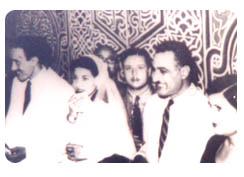
Weddings: Wedding ceremonies vary according to financial status, religion and social orientation, but food is all important here. Three constants won’t change, regardless of budget: one is the wedding cake; the second is the rose or almond sherbet, which is the single congratulatory drink in Egypt (for which Tamvaco, and incidentally, the originally Alexandrian Groppi, were especially famous); and the third is dragées, the sugar coated almonds – the last two are served on major happy occasions such as getting engaged, getting married, or getting a degree. Food is usually an open buffet, and rarely a seated dinner. It is increasingly becoming an opportunity to show off, but that too is regulated by budget. The wealthy will impress guests by placing, in the form of mezzeh, smoked salmon and salted nuts and asparagus on the tables, for the guests to munch on till the buffet is opened in the small hours of the morning, followed by marrons glacés and fancy chocolate. The less well-to-do will often hand out lunch boxes, with a sandwich, a piece of cake (called basta – probably a mutation of “pastry”), and a left-over complex from the days of socialism and deprivation: a red apple – possibly, too, sharing a tradition held by the Armenians of offering an apple not only on the feast of Sarkis, the equivalent of St Valentine’s Day, as a token of love, but of presenting a red apple following the consummation of the marriage. Whether this is consciously derived from intercultural exchange or has just gradually found its way into our habits is difficult to decide. And from socialism and this kind of cultural exchange to capitalism and the influx of the American influence (the new cultural exchange): cans of coke and Seven Up. The hostess will often be seen harassing guests with “Here, have a canz. Have you taken a canz? Canz, Canz!”
One feature in wedding buffets, of whatever category, is that it will have little connection with the regular diet of the household of the families involved. Whether westernized or not, they will most likely opt for a Western style menu, with the common fixture of macaroni béchamel, a great favorite with all Egyptians, and always considered a treat both because the knowledge of béchamel, let alone how to make it, will imply some culinary and intercultural sophistication, and because of the taste savored by all. Desserts, on the other hand, will be a combination of both West and Eastern cuisines, with the regular crème caramel, profiteroles, jelly as well as oriental pastries, and the all time favorite Om Ali. New is the chocolate fountain, a great favorite especially with the very young – Alexandrians are chocolate lovers, nurtured by a historic legacy of Swiss and French chocolotiers.
As the bride and groom prepare to leave, signaling the end of the wedding, they are often showered (as they may have been on their entrance) with coins of value depending on the relative affluence of the bride and groom. However, a tradition kept by all alike is to shower them with grains of rice and peas for prosperity and fertility.